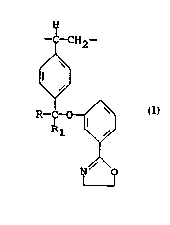Some of the information on this Web page has been provided by external sources. The Government of Canada is not responsible for the accuracy, reliability or currency of the information supplied by external sources. Users wishing to rely upon this information should consult directly with the source of the information. Content provided by external sources is not subject to official languages, privacy and accessibility requirements.
Any discrepancies in the text and image of the Claims and Abstract are due to differing posting times. Text of the Claims and Abstract are posted:
| (12) Patent Application: | (11) CA 2170137 |
|---|---|
| (54) English Title: | NOVEL FUNCTIONALIZED ISOOLEFIN/PARA-ALKYSTYRENE COPOLYMERS |
| (54) French Title: | NOUVEAUX COPOLYMERES FONCTIONNALISES D'ISOOLEFINE ET DE PARA-ALKYLSTYRENE |
| Status: | Deemed Abandoned and Beyond the Period of Reinstatement - Pending Response to Notice of Disregarded Communication |
| (51) International Patent Classification (IPC): |
|
|---|---|
| (72) Inventors : |
|
| (73) Owners : |
|
| (71) Applicants : |
|
| (74) Agent: | BORDEN LADNER GERVAIS LLP |
| (74) Associate agent: | |
| (45) Issued: | |
| (86) PCT Filing Date: | 1994-09-15 |
| (87) Open to Public Inspection: | 1995-03-23 |
| Examination requested: | 2001-03-01 |
| Availability of licence: | N/A |
| Dedicated to the Public: | N/A |
| (25) Language of filing: | English |
| Patent Cooperation Treaty (PCT): | Yes |
|---|---|
| (86) PCT Filing Number: | PCT/US1994/010401 |
| (87) International Publication Number: | WO 1995007945 |
| (85) National Entry: | 1996-02-22 |
| (30) Application Priority Data: | ||||||
|---|---|---|---|---|---|---|
|
The present invention comprises a functionalized polymer of an isoolefin
having from about 4 to about 7 carbon atoms and a para-alkyistyrene wherein
the functionalized polymer comprises a para-alkylstyrene moiety represented
by formula (I), wherein R and R1 are independently selected from the group
consisting of hydrogen, alkyl and primary and secondary alkyl halides.
L'invention concerne un polymère fonctionnalisé d'une isooléfine possédant environ 4 à environ 7 atomes de carbone et d'un para-alkylstyrène, lequel polymère fonctionnalisé possède une fraction para-alkylstyrène représentée par la formule (I), dans laquelle R et R1 sont sélectionnés indépendamment dans le groupe composé de l'hydrogène, d'un alcoyle et d'halogénures d'alcoyle primaires et secondaires.
Note: Claims are shown in the official language in which they were submitted.
Note: Descriptions are shown in the official language in which they were submitted.

2024-08-01:As part of the Next Generation Patents (NGP) transition, the Canadian Patents Database (CPD) now contains a more detailed Event History, which replicates the Event Log of our new back-office solution.
Please note that "Inactive:" events refers to events no longer in use in our new back-office solution.
For a clearer understanding of the status of the application/patent presented on this page, the site Disclaimer , as well as the definitions for Patent , Event History , Maintenance Fee and Payment History should be consulted.
| Description | Date |
|---|---|
| Inactive: IPC from MCD | 2006-03-12 |
| Inactive: IPC from MCD | 2006-03-12 |
| Application Not Reinstated by Deadline | 2004-09-15 |
| Time Limit for Reversal Expired | 2004-09-15 |
| Deemed Abandoned - Failure to Respond to Maintenance Fee Notice | 2003-09-15 |
| Amendment Received - Voluntary Amendment | 2001-05-14 |
| Amendment Received - Voluntary Amendment | 2001-04-02 |
| Letter Sent | 2001-03-22 |
| Inactive: Status info is complete as of Log entry date | 2001-03-21 |
| Inactive: Application prosecuted on TS as of Log entry date | 2001-03-21 |
| Request for Examination Requirements Determined Compliant | 2001-03-01 |
| All Requirements for Examination Determined Compliant | 2001-03-01 |
| Application Published (Open to Public Inspection) | 1995-03-23 |
| Abandonment Date | Reason | Reinstatement Date |
|---|---|---|
| 2003-09-15 |
The last payment was received on
Note : If the full payment has not been received on or before the date indicated, a further fee may be required which may be one of the following
Please refer to the CIPO Patent Fees web page to see all current fee amounts.
| Fee Type | Anniversary Year | Due Date | Paid Date |
|---|---|---|---|
| MF (application, 3rd anniv.) - standard | 03 | 1997-09-15 | 1997-06-26 |
| MF (application, 4th anniv.) - standard | 04 | 1998-09-15 | 1998-06-17 |
| MF (application, 5th anniv.) - standard | 05 | 1999-09-15 | 1999-06-29 |
| MF (application, 6th anniv.) - standard | 06 | 2000-09-15 | 2000-08-01 |
| Request for examination - standard | 2001-03-01 | ||
| MF (application, 7th anniv.) - standard | 07 | 2001-09-17 | 2001-06-27 |
| MF (application, 8th anniv.) - standard | 08 | 2002-09-16 | 2002-08-12 |
| MF (application, 2nd anniv.) - standard | 02 | 1996-09-16 |
Note: Records showing the ownership history in alphabetical order.
| Current Owners on Record |
|---|
| EXXON RESEARCH & ENGINEERING COMPANY |
| Past Owners on Record |
|---|
| DENNIS G. PEIFFER |
| DONG-TSAI HSEIH |
| HSIEN-CHANG WANG |